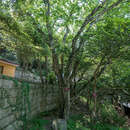Comments
provided by eFloras
An endangered species, with only one individual known in the wild.
- license
- cc-by-nc-sa-3.0
- copyright
- Missouri Botanical Garden, 4344 Shaw Boulevard, St. Louis, MO, 63110 USA
Description
provided by eFloras
Trees to 15 m tall; bark brown-gray. Branchlets brown, sparsely villous. Petiole 5-10 mm, sparsely pubescent; leaf blade elliptic or broadly elliptic, 5-10 × 3.5-5 cm, abaxially sparsely pubescent especially along midvein and lateral veins, bearded in axils of lateral veins, adaxially sparsely villous when young, base rounded or broadly cuneate, margin irregularly and doubly setiform serrate, apex acute or acuminate; lateral veins 11-14 on each side of midvein. Female inflorescence 3-8 × 4-5 cm; peduncle 1.5-3 cm, sparsely villous or glabrescent; bracts semiovate, 2.8-3 cm × ca. 8 mm, middle lobe semiovate, outer margin irregularly remotely serrate, without basal lobe, inner margin entire or subundulate, with ovate, inflexed basal lobe, apex rounded or obtuse; veins 3-5, reticulate veins prominent. Nutlet broadly ovoid, ca. 6 × 4 mm, glabrous, except villous at apex, sometimes with sparse glands, prominently ribbed. Fl. May-Jun, fr. Jul-Sep.
- license
- cc-by-nc-sa-3.0
- copyright
- Missouri Botanical Garden, 4344 Shaw Boulevard, St. Louis, MO, 63110 USA
Habitat
provided by eFloras
* Subtropical broad-leaved forests; 200-300 m.
- license
- cc-by-nc-sa-3.0
- copyright
- Missouri Botanical Garden, 4344 Shaw Boulevard, St. Louis, MO, 63110 USA
Carpinus putoensis: Brief Summary
provided by wikipedia EN
Carpinus putoensis (Putuo hornbeam, Chinese: 普陀鹅耳枥) is a species of plant in the family Betulaceae. It is a small tree, up to 15 metres (49 ft) tall.
It is endemic to Zhoushan archipelago in China where it survives as a single tree on Putuo Island. It is monoecious, thereby in principle still able to reproduce sexually in the wild. According to Edward O. Wilson, this is an example of what conservation biologists call "living dead" species.
- license
- cc-by-sa-3.0
- copyright
- Wikipedia authors and editors

